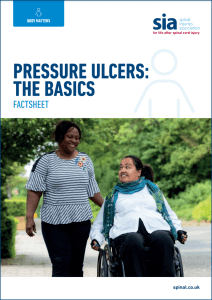Blog
Stop the Pressure Day 2024 - Lady Marie
“I know sometimes they can be busy and they’re short staffed, but that’s no excuse. There’s no excuse.”
In November 2019, Lady-Marie Dawson-Malcom from Balham was admitted to hospital with pneumonia but when she returned home after eight days, her carers discovered five pressure ulcers across her back and heels that left her on bed rest for a month.

This Stop the Pressure Day, Lady-Marie recalls her worst case of pressure ulcers and reflects on the healthcare inequalities for people with dark skin tones.
Lady-Marie sustained a spinal cord injury in 1992 as a result of domestic violence, leaving her paralysed from the chest down, meaning she is at risk of developing pressure ulcers. This condition can start as a tiny mark on the skin and develop into serious skin damage that requires bed rest and consistent care from healthcare professionals. On average, pressure ulcers cost the NHS £22.4 million per day, adding up to £8.2 billion per year.
According to Spinal Injuries Association, people with spinal cord injury are more at risk of developing pressure ulcers due to paralysis, leading to loss of both mobility and skin sensation.
As Lady-Marie cannot move or feel below the site of her injury in her neck, she relies on carers to check her skin for pressure ulcers.
Lady-Marie said, “Pressure ulcers are at bigger risk of going undiagnosed early for those with dark skin if you don’t have people you can trust to say there’s something wrong, or for them to actually check properly. I have to take it on faith that they’re actually physically using their hand to check because I can’t feel it. Having a light skin tone, of course, it’s much easier to actually see that there’s an issue because it presents as a red mark and then be able to rectify it before it gets really, really bad. This is not the case in dark skin.”
When Lady-Marie was first admitted to hospital for pneumonia, she immediately asked for a pressure relieving mattress that would help prevent pressure ulcers. She also reminded staff daily that they needed to check her skin by feeling for areas that were warmer or felt different to the rest of her skin. Once the pressure ulcer is visible, it is too late and the resulting damage leads to a lengthy healing process that would completely upend her life.
The first sign that something was wrong came when Lady-Marie started experiencing muscle spasms that were unusual to her. On the last day of her stay, staff discovered the problem. Lady-Marie said, “It transpired that the mattress that I was lying on wasn’t actually being inflated. So, though it was plugged in, the power wasn’t there because there was something wrong with it. I was lying literally on whatever the bed is made out of, and the mattress which did not have air in it.”
When she was discharged, Lady-Marie was left for six hours without being turned. After eight days on an uninflated mattress, with her heels pressed against the metal bedframe, and now six hours in the discharge lounge, she was disappointed but not surprised when carers found three pressure ulcers on her back and two on her heels.
Lady-Marie was forced to go on bed rest until the wounds had healed to prevent further complications that could lead to infection and even life-threatening sepsis. While pressure ulcers can take months, or even years, to heal, Lady-Marie was on bed rest for a month, causing her mental health to seriously decline. She said, “I’m not somebody that’s stressed very much, but being stuck in bed, that’s when I felt disabled. When I’m sitting up in my wheelchair, I’m fine. But being stuck in bed, no, not nice at all.

“It’s like you’re helpless, you feel helpless. I’ve been taught by the spinal unit how serious pressure ulcers are and that it can take a long while to heal. At the back of my mind, that’s what worried me more than anything else.”
Lady-Marie’s pressure ulcers could have been prevented if hospital staff had checked her skin as she instructed them. Instead, they looked for signs of redness, following guidelines for white skin. As a black woman, Lady-Marie’s skin did not present with the redness they expected and they missed the signs until it was too late.
For Lady-Marie, knowing that something was wrong and instructing staff on how to fix it was not the simple solution it should have been. She said, “That is the most frustrating thing because, as someone with a spinal cord injury, we know our skin, we know what to look for, but we need help. And the fact that when we’re trying to verbalise it, especially to some of these healthcare professionals who you think should know better and they’re not listening to you.”
“When they’re not listening, I get frustrated because I’m thinking, ‘I don’t want to be stuck in bed. I don’t want to get depressed at all. Please listen to me.”
Stop the Pressure Stories

When Ifeanyi (Ify) Nwokoro (34) from Middlesborough developed seven pressure ulcers that left him on bed rest for most of a year, he started to lose hope that he would ever get up again.
This condition can start as a tiny mark on the skin and develop into serious skin damage that requires bed rest and consistent care from healthcare professionals. On average, pressure ulcers cost the NHS £22.4 million per day, adding up to £8.2 billion per year.
